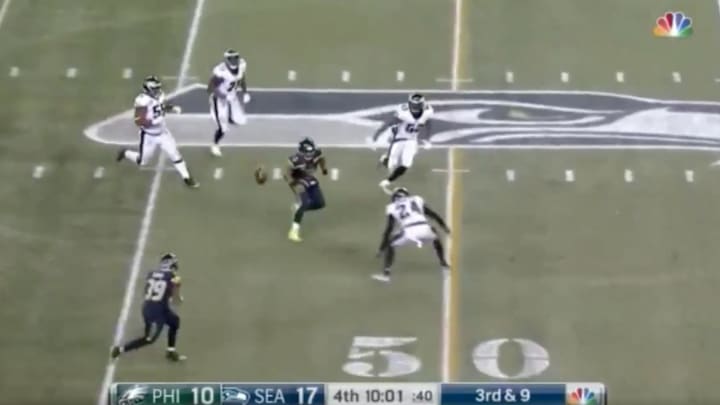Neil deGrasse Tyson Says Russell Wilson's Lateral Was a 'Galilean Tranformation'

With just over ten minute left in the fourth quarter of Sunday night's game between the Seahawks and Eagles, Russell Wilson and Seattle faced a crucial third-and-nine at their own 41-yard line. The Seahawks were up 17-10, so the Eagles desperately needed a stop to get the ball back and hopefully tie the game.
Philly's defensive line pressure Wilson from the outside, so he escaped through a gap in between the defenders. Wilson shook off a tackle attempt from Chris Long and decided to try and run for the first, but he was soon met by two converging linebackers who were in position to stop him before reaching the line-to-gain. Wilson then showed off his unmatched improvisational skills and pitched the ball to running back Mike Davis, who took it all the way to the Eagles' 35.
It was essentially a game-winning play; Wilson later found J.D. McKissic for a touchdown pass that pushed Seattle's lead to 24-10, which was the final score.
But the lateral never should have been allowed in the first place. Who better than noted physicist Neil deGrasse Tyson to explain why?
FYI: The lateral that @DangeRussWilson threw to @MikeDavisRB in Sunday’s @Seahawks @Eagles game was a legit “Galilean Transformation”. In their reference frame, the ball went backwards. It’s not their fault they ran forward faster than the ball. pic.twitter.com/DHUKNtlcyj
— Neil deGrasse Tyson (@neiltyson) December 5, 2017
The basic concept here (in woefully undersimplified terms) is that because Wilson and Davis were moving forward faster than the ball moved forward, the ball actually appeared to move backward. If you slow down the video considerably, you can see that Wilson releases the ball just before the 47-yard line, while Davis receives it somewhere between the 48 and 49. Because Davis was behind Wilson when Wilson tossed it, the lateral did initially look legal.
It gets a little bit more complicated, unfortunately. In Wilson and Davis' reference frame, as deGrasse Tyson mentioned, the ball actually did travel backwards. But their reference frame is altered because of the speed with which they were moving. If he had tossed the ball directly sideways within his frame of motion, the ball would have moved forward at the same speed he was moving. This is why you're able to toss a ball up and down in a moving car and not have it immediately hit the back of the vehicle. Straight up-and-down in that reference frame is actually the speed at which your body is moving forward within the car.
Still, the lateral was illegal because whether a lateral is forward is not determined by the runner's frame of reference. Here's the rule verbatim:
Rule 3, Section 22, Article 4:
"It is a forward pass if:
a. the ball initially moves forward (to a point nearer the opponent's goal line) after leaving the passer's hand(s);"
I feel like you guys get the point by now, so let's cut off the physics talk and just appreciate deGrasse Tyson's ability to apply advanced physics to real-world situations.
